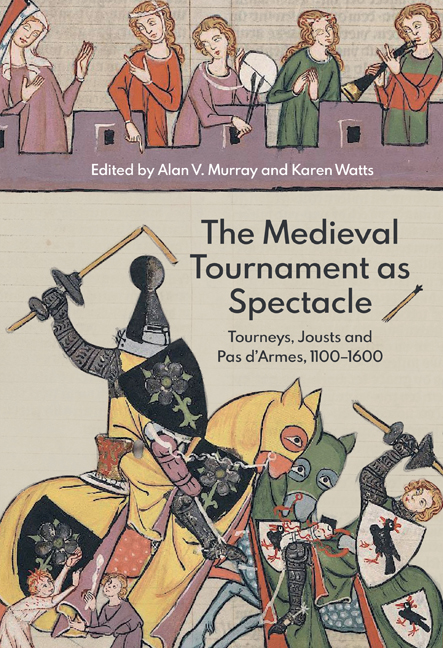Book contents
- Frontmatter
- Contents
- List of Illustrations
- List of Contributors
- Preface and Acknowledgements
- Introduction: From Mass Combat to Field of Cloth of Gold
- Research on the Medieval Tournament (1100–1600): A Select Bibliography
- 1 Now Form Up Close Together! Tactics and Ethos of the Tourney in Early German Sources (Twelfth to Thirteenth Centuries)
- 2 Por pris et por enor: Ideas of Honour as Reflected in the Medieval Tournament
- 3 Richard II of England and the Smithfield Tournament of October 1390: An Instrument to Establish Royal Authority
- 4 Alle myn harneys for the justes: Documents as a Source for Medieval Jousting Armour
- 5 The Tournament Saddle
- 6 Between Sport and Theatre: How Spectacular was the Pas d’armes?
- 7 Art Imitating Life Imitating Art? Representations of the Pas d’armes in Burgundian Prose Romance: The Case of Jehan d’Avennes
- 8 The Foot Combat as Tournament Event: Equipment, Space and Forms
- 9 Power and Pageantry: The Tournament at the Court of Maximilian I
- 10 The Field of Cloth of Gold: Arms, Armour and the Sporting Prowess of King Henry VIII and King Francis I
- Appendix 1 Calendar of the Royal Combats at the Field of Cloth of Gold, June 1520
- Appendix 2 Articles for the Challenge: The Emprise
- Index of Objects
- Index of Manuscripts
- General Index
3 - Richard II of England and the Smithfield Tournament of October 1390: An Instrument to Establish Royal Authority
Published online by Cambridge University Press: 11 September 2020
- Frontmatter
- Contents
- List of Illustrations
- List of Contributors
- Preface and Acknowledgements
- Introduction: From Mass Combat to Field of Cloth of Gold
- Research on the Medieval Tournament (1100–1600): A Select Bibliography
- 1 Now Form Up Close Together! Tactics and Ethos of the Tourney in Early German Sources (Twelfth to Thirteenth Centuries)
- 2 Por pris et por enor: Ideas of Honour as Reflected in the Medieval Tournament
- 3 Richard II of England and the Smithfield Tournament of October 1390: An Instrument to Establish Royal Authority
- 4 Alle myn harneys for the justes: Documents as a Source for Medieval Jousting Armour
- 5 The Tournament Saddle
- 6 Between Sport and Theatre: How Spectacular was the Pas d’armes?
- 7 Art Imitating Life Imitating Art? Representations of the Pas d’armes in Burgundian Prose Romance: The Case of Jehan d’Avennes
- 8 The Foot Combat as Tournament Event: Equipment, Space and Forms
- 9 Power and Pageantry: The Tournament at the Court of Maximilian I
- 10 The Field of Cloth of Gold: Arms, Armour and the Sporting Prowess of King Henry VIII and King Francis I
- Appendix 1 Calendar of the Royal Combats at the Field of Cloth of Gold, June 1520
- Appendix 2 Articles for the Challenge: The Emprise
- Index of Objects
- Index of Manuscripts
- General Index
Summary
A formal tournament was held at Smithfield on 10 October, providing the nobles and gallant knights of many areas a reason for visiting London … The tournament lasted three days, on the first of which the honours were awarded to the king.
The spectacle of the tournament was surely at its height when the monarch of a nation was involved, as King Richard II of England was at Smithfield in October 1390. Certainly, the image of Richard's involvement in a tournament may be unfamiliar to a modern reader, unaccustomed to a martial presentation of the much-maligned king. Nevertheless, Richard offered his own patronage of tournaments on several occasions, and in October 1390 held one of the grandest and most successful tournaments of his reign.
Tournaments themselves were great chivalric occasions throughout the medieval world, where individual prowess could be demonstrated for all to see. Arranged and organised for the nobility, they encapsulated and embodied the images and ideals of knighthood and chivalry, and might also include women and people of lower social groups as spectators. Despite a growing appreciation for show and display, however, the tournament was not a vainglorious pursuit of the nobility. It could also be a weapon of politics, where plans, schemes and reputations could be made or destroyed, and even lives lost. It could be used to challenge the power of a monarch and embed factionalism at court. But it could also be an instrument used to help establish royal authority and bring tangible benefits to any monarch who could wield this instrument correctly. To demonstrate this, I will briefly explore the politicisation of the tournament in England before examining the Smithfield tournament of 1390 in detail. By examining the participants in the tournament, the symbolism incorporated into the event, and the nature of Richard's own involvement, it is possible to see how he attempted to manipulate the tournament and wield it for his own purposes. It was not simply a spectacle, but a manifestation of power.
The exact date of the origin of tournaments is not known, but they were well established by the mid-twelfth century. Almost from the outset, tournaments were politicised events in England. During the civil wars between King Stephen (1135–54) and the Empress Matilda (1139–67) tourneying took place between the two respective sides.
- Type
- Chapter
- Information
- The Medieval Tournament as SpectacleTourneys, Jousts and Pas d'Armes, 1100-1600, pp. 62 - 76Publisher: Boydell & BrewerPrint publication year: 2020

